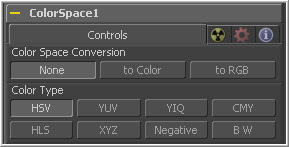Eyeon:Manual/Tool Reference/Color/Color Space
From VFXPedia
< Eyeon:Manual | Tool Reference | Color
|
Color Tools |
|
Color Space
|
Contents |
Controls Tab
Color Space Conversion
This button array has three options.
- None
- The color space tool has no effect on the image.
- To Color
- The input image will be converted to the color space selected in the Color Type control found below.
- To RGB
- The input image will be converted back to the RGB color space from the type selected in the Color Type control below (for example, YUV to RGB).
- Color Type
- These buttons are used to select the color space conversion applied when the To Color conversion is selected.
- HSV (Hue, Saturation And Value)
- Each pixel in the HSV color space is described in terms of its Hue, Saturation and Value components. Value is defined as the quality by which we distinguish a light color from a dark one or brightness. Decreasing saturation roughly corresponds to adding white to a paint chip on a palette. Increasing value is roughly similar to adding black.
- YUV (Luma, Blue Chroma And Red Chroma)
- The YUV color space is used in the analog broadcast of PAL video. This format is often used to color correct images, due to its familiarity to a large percentage of video engineers. Each pixel is described in terms of its Luminance, Blue Chroma and Red Chroma components.
- YIQ (Luma, In Phase And Quadrature)
- The YIQ color space is used in the analog broadcast of NTSC video. This format is much rarer than YUV and almost never seen in production. Each pixel is described in terms of its Luminance, Chroma (in-phase or red-cyan channel) and Quadrature (magenta-green) components.
- CMY (Cyan, Magenta And Yellow)
- Although more common in print, the CMY format is often found in computer graphics from other software packages. Each pixel is described in terms of its Cyan, Magenta and Yellow components. CMY is non-linear.
- HLS (Hue, Luminance And Saturation)
- Each pixel in the HLS color space is described in terms of its Hue, Luminance and Saturation components. The differences between HLS and HSV color spaces are minor.
- XYZ (CIE Format)
- This mode is used to convert a CIE XYZ image to and from RGB color spaces. CIE XYZ is a weighted space, rather than a non-linear one, unlike the other available color spaces. Non-linear in this context means that equal changes in value at different positions in the colour space may not necessarily produce the same magnitude of change visually to the eye.
Expressed simply, the CIE color space is a perceptual color system, with weighted values obtained from experiments where subjects were asked to match an existing light source using three primary light sources.
This color space is most often used to perform gamut conversion and color space matching between image display formats because it contains the entire gamut of perceivable colors.
- Negative
- The color channels are inverted.The color space remains RGBA.
- BW
- The image is converted to black and white. The contribution of each channel to the luminance of the image is adjustable via slider controls that appear when this option is selected. The default values of these sliders represent the usual perceptual contribution of each channel to an images luminance. The color space of the image remains RGBA.
| The contents of this page are copyright by eyeon Software. |

